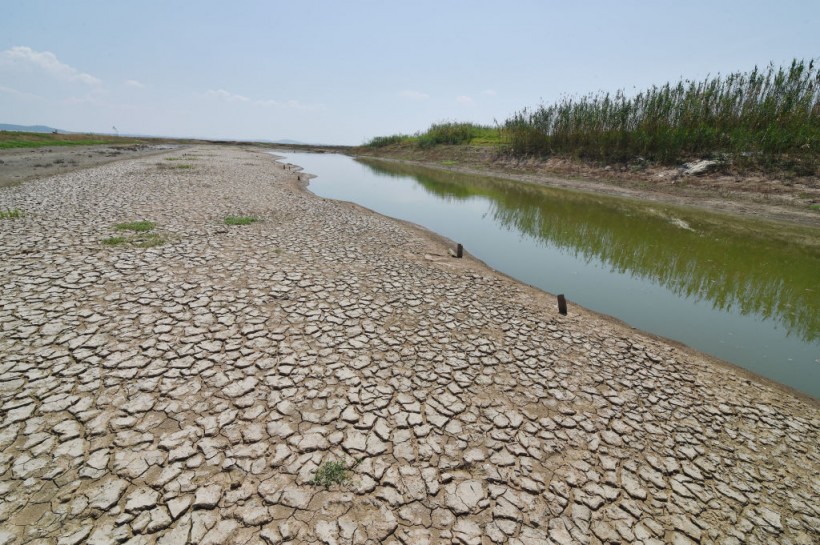The Yangtze River plunges, revealing 600-year-old monuments. Three ancient figures are carved into an oblong stone that has emerged from the bed of a drying river. They are thought to have originated during the Ming era when Buddhism in China reached its pinnacle.
Intense Heat

This photo taken on August 21, 2022 shows dry sections of a lake in Nanjing in China's eastern Jiangsu province.
A record-breaking heat wave that has been going on for 70 straight days. In addition to the heat, extreme dryness has led to record drought conditions in several areas, including Yangtze River Valley. Yangtze River is Asia's longest and third biggest river in the world.
Finding Artifacts
In the municipality of Chongqing in southwest China, parts of the Yangtze River have receded so considerably that ancient sculptures from the Ming and Qing periods have been unearthed. An oblong stone that once jutted out of the Foyeliang island reef, which was once submerged in the Yangtze River, today has three ancient Buddhist sculptures.
Based on an examination of the sculptures' designs, experts estimate that they were carved about 600 years ago. Buddhism flourished in China throughout the Ming era, lasted from 1368 to 1644, and was ingrained into everyday life.
It is not the first time underwater Buddha sculptures have been found in China. A Buddha sculpture has been discovered in China's Inner Mongolia region. Another Buddha sculpture was found in Jiangxi Province in 2017. The Ming Dynasty is thought to be its original period of origin.
Also Read: Rare Discovery: Archaeological Excavation in Pompeii Unearths Remains of Pregnant Tortoise
Drying Up Rivers
On August 19, the China Meteorological Administration issued its first annual national drought notice in response to the Yangtze River's low water levels and worries about severe water shortages.

This photo taken on August 21, 2022 shows dry sections of a lake in Nanjing in China's eastern Jiangsu province.
According to AccuWeather's Lead International Forecaster Jason Nicholls, "Rainfall has been below average in the Yangtze River Valley since May due to prolonged ridging over the region since July that has contributed to the repeated heat waves."
The hydroelectric supply, on which several Chinese provinces strongly rely, has now started to be impacted by the persistent effects of heat and drought on river levels in some regions of China. According to Bloomberg News, the Sichuan Province in southwest China uses hydropower for around 82% of its energy needs. The low river levels are causing significant shipping delays and the closure of several businesses.
This summer, a local media station in Sichuan reported to The Guardian that there had been a 25% rise in the power demand. Residents have turned up the air conditioning because of the high temperatures and the extended heat wave, significantly increasing energy consumption.
Since June, temperatures have been, on average, around 5 degrees Fahrenheit (3 degrees Celsius) above average, according to forecasters.
Energy Watch
According to a statement from the province administration of Sichuan, the water supply to the local reservoirs has been cut in half. Hydropower-related problems have trickled down from Sichuan to the municipalities of Chongqing City and the Hubei Province.
The province last week halted or restricted the electricity supply to thousands of industries and the general public due to the scarcity. Production will resume this next week, according to the plans.
According to AccuWeather projections, the heat wave could not end until mid-to-late next week.
Extended Heat Period
According to Nicholls, Tuesday will see a continuation of the current hot wave in these places. As the ridge of high pressure dissipates, temperatures will start to move downward on Wednesday.
Additionally, it is anticipated that there will be more rain in the region in the coming days, which will lessen the effects of the drought.
Nicholls said, "A stalled front can provide some much-needed rain to the area Friday through early next week."
Related Article: Authorities to Restore Parts of the Stonehenge
For more similar news, don't forget to follow Nature World News!
© 2024 NatureWorldNews.com All rights reserved. Do not reproduce without permission.

![Tsunami Hazard Zones: New US Map Shows Places at Risk of Flooding and Tsunamis Amid Rising Sea Levels [NOAA]](https://1471793142.rsc.cdn77.org/data/thumbs/full/70325/280/157/50/40/tsunami-hazard-zones-new-us-map-shows-places-at-risk-of-flooding-and-tsunamis-amid-rising-sea-levels-noaa.jpg)



